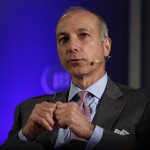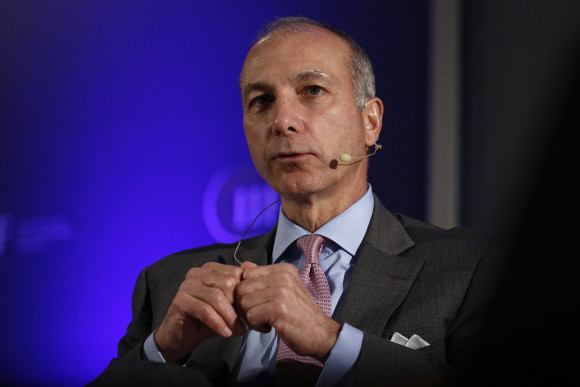After regulators slapped the too-big-to-fail label on MetLife Inc., Chief Executive Officer Steve Kandarian had several responses. One was to challenge government watchdogs in court — a move shunned by other insurers that got the TBTF tag. The CEO also scaled back share buybacks to guard capital, and he announced a plan to make the company smaller.
Now that a federal judge has struck down the designation, Kandarian may have more flexibility on his plan to eventually have a sale, spinoff or public offering of a U.S. retail operation. And he could return more funds to shareholders, as he faces less of a threat of tighter capital rules. He may even be able to price insurance products more competitively after saying that Federal Reserve oversight would put his company at a disadvantage against less-regulated rivals.
“Kandarian can take a victory lap,” Robert Haines, an analyst at CreditSights, said in a phone interview after a U.S. judge ruled in the insurer’s favor Wednesday. “Big victory for MetLife shareholders.”
MetLife rallied about 5.3 percent to $44.73 at 4:15 p.m. in New York, the largest advance in the 90-company Standard and Poor’s 500 Financials Index. American International Group Inc. and Prudential Financial Inc., the other two insurers that were designated as non-bank systemically important financial institutions, posted the next biggest gains in the index, with each climbing at least 2 percent.
AIG, Prudential
Shareholders of AIG and Prudential will probably push those companies to challenge their SIFI designations as well, Haines said.

MetLife CEO
At Prudential, “we continuously review developments that impact our company, and we are evaluating what is in the best interests” of shareholders, Scot Hoffman, a spokesman for the Newark, New Jersey-based insurer, said in a statement. A spokesman for AIG declined to comment.
MetLife stock could be worth an extra $6 a share without the SIFI designation, John Nadel, an analyst at Piper Jaffray Cos., said in a note to clients. Without tighter capital rules that come with the label, the New York-based insurer could have an additional $2.5 billion or more to return to shareholders or deploy in other ways, he wrote.
Kandarian’s View
“We’ll be studying all this over the coming days and weeks,” Kandarian said in a phone interview, when asked about the prospects for increased buybacks. He said that the U.S. has 60 days to file an appeal.
Kandarian said MetLife intends to follow through with plans, announced in January, to separate the retail unit. “They’ll proceed along the lines that we’ve been contemplating,” he said. The Treasury Department said Wednesday that it strongly disagrees with the court’s decision and will continue to defend the designations process at the Financial Stability Oversight Council, the body that declared MetLife a SIFI.
Interest Rates
The retail unit slated for separation is a provider of variable annuities, where results can be tied to fluctuations in stock markets and interest rates. Sean Dargan, an analyst at Macquarie Group Ltd., said it still makes sense to limit those risks, whether or not MetLife is a SIFI. Still, Dargan said that the court victory may reduce time pressure to complete a deal, a pace that could allow Kandarian to get a better price.
The government oversight council was created by the 2010 Dodd-Frank law and charged with monitoring potential threats to the financial system after the near collapse in 2008 of companies including AIG, which required a U.S. bailout that swelled to $182.3 billion. While the largest banks automatically get tighter oversight, the council had to decide which other companies should be classified as SIFIs.
MetLife was one of the largest financial companies that didn’t take a Treasury Department rescue in the credit crisis. Kandarian has long said that his company doesn’t face the same risks as banks because it doesn’t have as much of its funds subject to immediate withdrawals. On some life policies, insurers collect periodic premiums and make payments only when a customer dies. Kandarian also said that life insurers are well supervised at the state level, a stance that won support among some industry watchdogs.
“All of the relevant state insurance regulators, myself included, were publicly opposed” to MetLife’s designation process, said Tom Leonardi, the former insurance commissioner of Connecticut who now works at investment bank Evercore Partners Inc.
Shareholder Pressure
AIG CEO Peter Hancock has said he’s comfortable with Federal Reserve oversight, a stance that drew the ire of billionaire investor Carl Icahn. The activist said last year that Hancock should break the company into three separate insurers to help avoid SIFI status. AIG subsequently announced plans to sell some assets and nominated a representative of Icahn’s firm to the insurer’s board.
“AIG has activist investors who have been pushing really strong for AIG to split up as a company to avoid the SIFI designation,” Haines said. “AIG has fought that push and, right now, seems to be acquiescing to the SIFI designation. But this is just going to increase investor, shareholder pushes for these companies to consider moves to avoid the designation.”
Was this article valuable?
Here are more articles you may enjoy.



 Viewpoint: Artificial Intelligence Is Rewriting the Rules for Commercial Lines
Viewpoint: Artificial Intelligence Is Rewriting the Rules for Commercial Lines  North Carolina Sting Operation Alleges Roofer Damaged Shingles to File Claim
North Carolina Sting Operation Alleges Roofer Damaged Shingles to File Claim  Underwriter, Actuary Fears of AI Drop; Work Needed on Collaboration
Underwriter, Actuary Fears of AI Drop; Work Needed on Collaboration  Former CEO of Nonprofit P/C Statistical Agent Sentenced for Stealing Millions
Former CEO of Nonprofit P/C Statistical Agent Sentenced for Stealing Millions 

